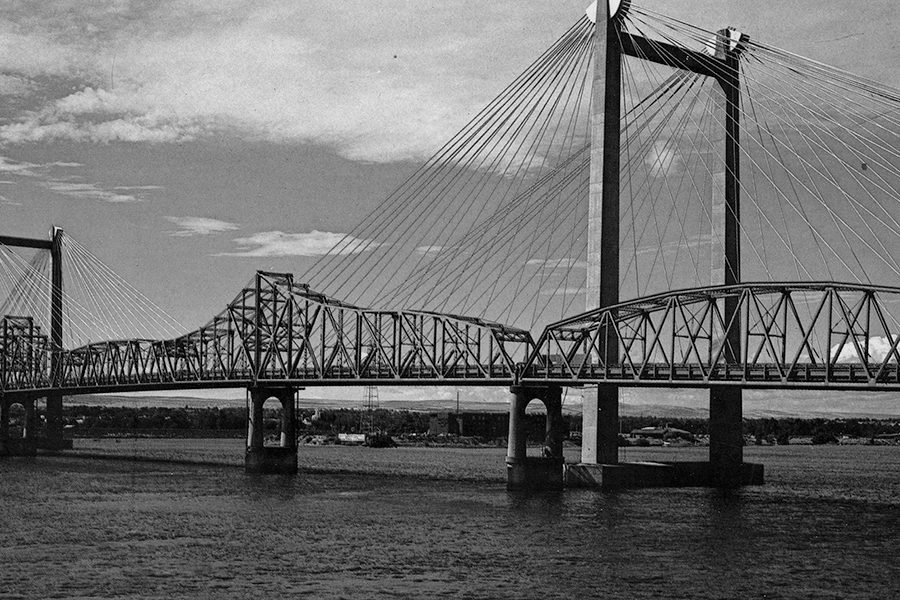
Home » Happy 100th birthday to the old green bridge
Happy 100th birthday to the old green bridge

May 11, 2022
By Gale Metcalf for Tri-Cities Area Journal of Business
A century ago, the automobile had not yet completely replaced the horse and buggy as the main way of getting around in the United States.
But, it was getting there.
Yet getting to where you wanted to be – even with an automobile and the many more horses of power it had in its engine compared to the four-legged working machine out in the pasture – was another matter.
Good roads were limited and many had natural obstacles.
If you wanted to drive from Massachusetts to Puget Sound on the Yellowstone Trail Highway, you had better be prepared to hop on a ferry between Pasco and Kennewick to complete your journey by car.
Until 1922.
The last road link on the Yellowstone Trail connecting the eastern seaboard of the United States with Washington state was completed with the opening of a 3,300-foot long, 185-foot high steel cantilever truss bridge across the Columbia River between Pasco and Kennewick.
This year marks the 100th year since the span we once called the green bridge debuted. The bridge opened Oct. 7, 1922.
Right at this moment a century ago, bridge construction was underway. It would take one year to build from beginning to end before opening the Yellowstone Trail to automobiles.
The Yellowstone Trail was the “first transcontinental automobile highway through the upper tier of the United States.”
It was established on May 23, 1912, some 10 years before the Pasco-Kennewick bridge was built. It ran from the Atlantic Ocean at Plymouth, Massachusetts, to Seattle, passing through Yellowstone National Park.
A slogan of the day identified the Yellowstone Trail as “a good road from Plymouth Rock to Puget Sound.”
Plans for an automobile bridge linking Pasco and Kennewick were in the minds of some even before considerations of a Yellowstone Trail link.
B.B. Horrigan, a young attorney who arrived in Pasco 1904, began thinking about a bridge in 1913.
Horrigan was a state legislator and would be appointed a Superior Court judge for the Benton-Franklin-Adams County Judicial District by Washington Gov. Mon C. Wallgren in 1945. Alas, Horrigan did not have funding at his vision.
But it came in 1919 when a representative of the Union Bridge Company, Charles G. Huber, sold $49,000 worth of stock to finance building the bridge, the first of its size paid entirely by stock sales.
Its dedication brought dignitaries and visitors from throughout the state and brought significant optimism to what the new span might mean to the state’s economy and to the two towns that now truly became the “Twin Cities.”
The Kennewick Courier-Reporter wrote then: “The day the bridge was opened to traffic, a new era dawned for each community.”
The Columbia River crossing wasn’t cheap. On its first day tolls were 75 cents a car, 20 cents for bicycles. Drivers of trucks weighing less than 1 ton paid $2.
Tolls were removed in 1931 after initial construction costs were paid and travel was free between Pasco and Kennewick for the next 47 years until the span was replaced by today’s cable bridge, with its much-need four lanes.
The cable bridge is west of the spot where the green bridge crossed. Vestiges of the old bridge remain on the shoreline.
By the time the cable bridge was built, the old, narrow two-lane bridge was straining to accommodate up to 18,000 cars a day.
Three cantilever bridges were built over the Columbia River in the 1920s. The Pasco-Kennewick span was the first.
In 1931, it was purchased by the state of Washington. In 1933, it was added to the state highway system.
Two decades later, in 1954, Benton and Franklin counties became owners, and in 1968 the bridge was sold by the counties to Pasco and Kennewick. The cities paid just $1.
In 1926, the bridge became part of the newly formed Highway 410, and when the highway was decommissioned in 1967, the bridge carried traffic on Highway 12.
The bridge had formal and informal names through the years, like the Pasco-Kennewick Bridge, and the Benton-Franklin Inter-County Bridge, but its lime-green luster seemed to forever mark it in local language as the “old green bridge.”
The morning of Sept. 16, 1978, the old green bridge was still used by traffic.
It closed to motor traffic forever when the new cable bridge was dedicated that day by Washington Gov. Dixie Lee Ray.
Local bridge preservationists, led by Virginia Devine as chairwoman of the Save Our Bridge Committee, sought for years to prevent its removal for historical reasons and for uses other than traffic.
In the end, those favoring its removal for navigation reasons prevailed and it was demolished in 1990, some 68 years after it opened. A bridge support extending from the water was left near the Kennewick shoreline, leading to the creation of a pier for scenic viewing.
The old Pasco-Kennewick green bridge was placed in the National Registry of Historic Places on July 16, 1982.
Search East Benton County History Museum: 205 W. Keewaydin Drive in Kennewick; 509-582-7704; ebchs.org.
Gale Metcalf, a lifelong Tri-Citian and retired Tri-City Herald employee, as well as a volunteer for the East Benton County Historical Society, writes the monthly history column.
Local News Transportation
KEYWORDS may 2022





